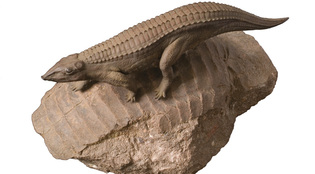 loading
loading
Arts & CultureObject lessonThe home of an ancient reptile—lost and found Copeland MacClintock is senior museum assistant in invertebrate paleontology at Yale's Peabody Museum of Natural History.  Jerry Domian/ Peabody MuseumA sculpted reconstruction of Aetosaurus arcuatus sits atop a fossil specimen of the reptile found in New Haven in 1895. View full imageIn 1895, O. C. Marsh of Yale’s Peabody Museum of Natural History acquired a rare fossil reptile found in New Haven. This is the story of how the fossil’s place of origin, once known in detail, became lost to science through misinformation and the passage of time, and then, just recently, was rediscovered. In the fall of 2008, the New Haven Bioregional Group asked me to provide geological commentary on a walk through a new park in Fair Haven Heights called Quarry Park. Researching the geology led me to the Peabody’s Jim Sirch, who mentioned that there was a famous fossil site somewhere in Fair Haven, and then to Dan Brinkman ’94MPhil in the vertebrate paleontology division. He guided me to the museum’s record of that find and to the 1896 publication in which Marsh had described the fossil, Aetosaurus arcuatus, a small, pig-snouted, alligator-like reptile—now known to be one of only four vertebrates from the red sandstone of the Late Triassic New Haven. Accession 2269 states, in part, “Rec’d. March 25, 1895. from Fair Haven East . . . Found in Jan., 1895 by Freeman P. Clark in his quarry [lease] on Grove Street (Annex), City of New Haven.” Subsequent descriptions of the site include such varied statements as, “quarry near Ferry St. bridge, Fair Haven,” “near the State Street bridge over the Quinnipiac River . . . in Fair Haven,” and “near Tomlinson bridge . . . in Fair Haven.” This information seemed vague at best and false at worst. State Street does not cross the Quinnipiac. What is the Annex, and where in Fair Haven is there a Grove Street? On our 2008 walk through Quarry Park, we stood on the northeast rim of a deep quarry just off Russell Street and talked about Marsh’s Aetosaurus. We had photographs and drawings of the reptile, but no hint of its “lost locality.” Then, two people on the walk offered some clues. Local historian Deb Townshend pointed out that the Annex was another name for what is now called Fair Haven Heights, and that Grove Street was the old name for Russell Street. Tracy Blanford, who lives on Russell Street, said we should talk with her neighbors Harry Clark Jr. and his son Dennis. Harry, it turns out, is the grandson of Freeman Plumb Clark, the quarryman who found the fossil. He remembers seeing Yale people with ropes and ladders visiting the northeast corner of the quarry, right across the street from him, year after year. These visits continued into the 1960s—then stopped, right about the time when Joseph Gregory, the last person at Yale who would be interested in Aetosaurus, left Yale. With his leaving, knowledge of the location slipped away, as did he in 2007. Harry Clark’s recollections about the northeast part of the quarry convinced us that we had found the discovery site of Aetosaurus arcuatus—directly below the spot where, the year before, we had talked about the “lost locality.” This time nothing will be left to chance. The pinpointed locality is 41°17.955' N, 72°52.967' W with a margin of error of five meters.
The comment period has expired.
|
|